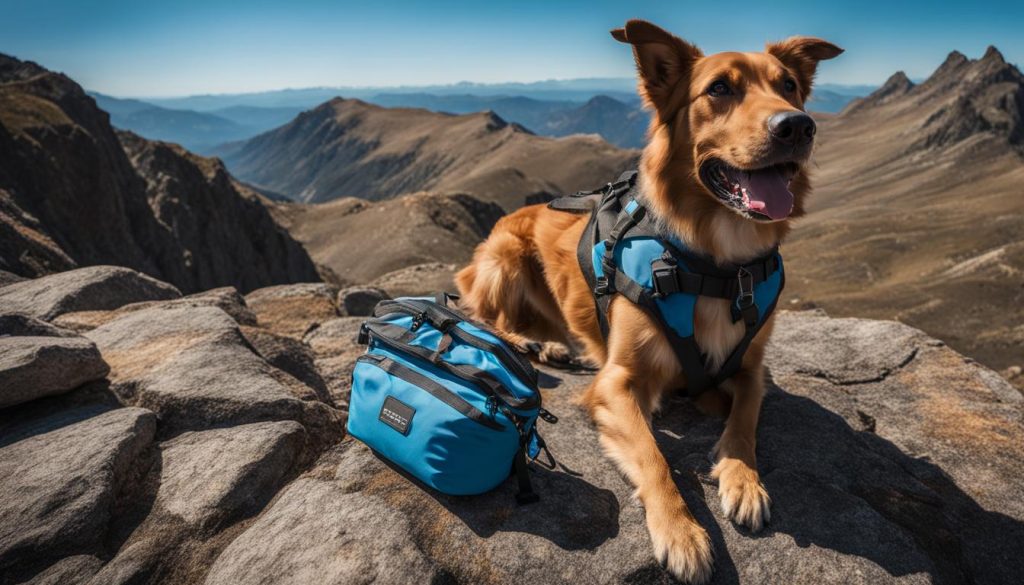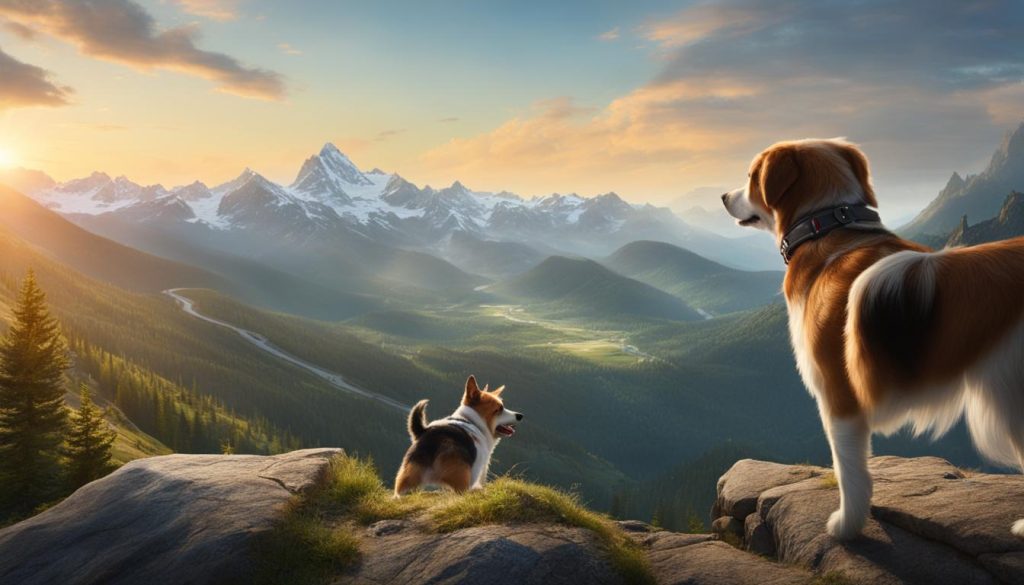Dog off-leash hiking is an exhilarating way to explore the great outdoors with your furry companion. There’s nothing quite like seeing your dog’s tail wagging with excitement as they run freely through the trails, taking in all the sights, smells, and sounds nature has to offer. But before you embark on this adventure, be prepared and informed.
From assessing your dog’s ability and developing trail skills to understanding trail etiquette and packing the right gear, there are several key factors to consider to ensure a safe and enjoyable experience for both you and your canine companion. In this guide, I will walk you through the essential steps and provide valuable tips for dog off-leash hiking.
Key Takeaways:
- Assess your dog’s ability and consider their endurance, health condition, and trail features.
- Train your dog in recall skills and general manners to enhance their safety and behavior on the trail.
- Follow trail etiquette, respect leash rules, and properly dispose of dog waste.
- Ensure you have the right gear, including water bottles, food, leashes, ID tags, first aid kit, and more.
- Plan your trips, be aware of weather conditions, and be prepared for emergencies.
Assessing Your Dog’s Ability
Before taking your dog on a hiking expedition, assess their ability to ensure a safe and enjoyable experience for both of you. Assessing your dog’s endurance, health condition, and their comfort level with different trail features will help determine if they are ready for more challenging hikes.
To determine your dog’s endurance, gradually increase the length and difficulty of your hikes over time. Start with shorter walks and gradually build up to longer distances. Observe how your dog handles these hikes and pay attention to any signs of fatigue or discomfort.
| Trail Features | Assessment Guidelines |
|---|---|
| Elevation Gain/Loss | Start with trails that have minimal elevation changes and gradually increase to more challenging terrains. |
| Terrain | Observe how your dog navigates different terrain types such as rocky surfaces, muddy paths, or uneven ground. |
| Trail Difficulty | Choose trails that match your dog’s fitness level and gradually progress to more difficult trails as their skills improve. |
It’s also important to consult with your veterinarian to ensure your dog is physically fit for hiking. They can provide guidance on any specific considerations based on your dog’s breed, age, and health condition. Regular check-ups and vaccinations will help keep your dog in optimal health for outdoor adventures.
Developing Trail Skills
Developing trail skills is crucial for a safe and enjoyable off-leash hiking experience with your dog. Whether you are a seasoned hiker or a beginner, teaching your dog recall skills, manners, and the importance of staying on the trail is essential. By focusing on these skills, you can ensure that your dog is well-behaved, respects the environment, and stays safe during your outdoor adventures.
Recall Skills for Dogs
Recall skills are vital for keeping your dog safe and under control while hiking off-leash. Teaching your dog to come when called ensures that they respond promptly to your command, even in distracting outdoor environments. Start by practicing recall in controlled settings, gradually increasing the level of distractions. Reward your dog with treats, praise, and playtime for coming when called, reinforcing the behavior. With consistent training and positive reinforcement, your dog will develop reliable recall skills.
Teaching Manners to Dogs
Manners are important during off-leash hiking to ensure that your dog is respectful of other hikers and wildlife. Teach your dog basic manners such as sitting, waiting, and staying on command. These commands help you manage your dog’s behavior and prevent them from approaching other hikers or wildlife without permission. Practice these manners in different environments to ensure that your dog can follow them consistently. Reward your dog for displaying good manners, and as they become more proficient, gradually decrease the frequency of treats while still offering verbal praise and physical affection.
Training Dogs to Stay on Trail
Training your dog to stay on the trail is essential for minimizing environmental damage and preventing accidents. Start by using a leash to guide your dog along the trail, rewarding them for staying in the designated path. Gradually transition to off-leash hiking in areas where it is permitted, reinforcing the idea that the trail is the safe and appropriate place to walk. If your dog starts to wander off the trail, use verbal cues or gentle redirection to bring them back onto the path. With consistent training and positive reinforcement, your dog will learn to stay on the trail and respect the boundaries set.

Training your dog to develop these trail skills takes time, patience, and consistency. By focusing on recall skills, teaching manners, and training your dog to stay on the trail, you can ensure a positive off-leash hiking experience for both you and your furry companion.
Understanding Trail Etiquette
When embarking on a dog off-leash hiking adventure, have a solid understanding of trail etiquette. By following proper trail etiquette, you can ensure a safe and enjoyable experience for both your dog and other hikers.
One key aspect of trail etiquette is respecting leash rules. While some trails may allow dogs to be off-leash, others may require dogs to be leashed at all times. I recommend that you be prepared to leash your dog in areas where it is required or requested by other hikers. This not only ensures the safety of other hikers, but also prevents potential conflicts with wildlife or other dogs.
Additionally, yield to other hikers on the trail. This means giving the right of way to other hikers, especially if the trail is narrow or there are limited passing opportunities. Practice commands like sit, wait, or stay to help your dog stay calm and well-behaved when encountering other hikers.
Proper disposal of dog waste is another crucial aspect of trail etiquette. Always carry waste bags with you and clean up after your dog. Bag the waste and either pack it out or dispose of it in designated waste bins. If no bins are available, consider burying the waste in a designated hole away from the trail. This helps to maintain the cleanliness of the trail and prevents the spread of disease.
Table: Trail Etiquette Guidelines
| Trail Etiquette Guidelines | Explanation |
|---|---|
| Respect leash rules | Follow trail regulations and leash your dog where required or requested. |
| Yield to other hikers | Give the right of way to other hikers, especially on narrow trails. |
| Practice commands | Train your dog to sit, wait, or stay to ensure they stay calm when encountering other hikers. |
| Proper disposal of dog waste | Always carry waste bags and dispose of dog waste in designated areas or bury it away from the trail. |
By adhering to these trail etiquette guidelines, you can contribute to a positive hiking experience for all and help maintain the integrity of the natural environment. To put it simply, a responsible dog owner not only enjoys the adventure of off-leash hiking but also respects the rights and safety of others on the trail.

Essential Gear for Dog Off-Leash Hiking
When embarking on a dog off-leash hiking adventure, have the right gear to ensure your furry companion’s safety and comfort. Here are some essential items that should be part of your hiking gear:
- Water bottle and dish: Just like humans, dogs need to stay hydrated while hiking. Carry a collapsible water bottle and a portable dish to provide your dog with fresh water along the way.
- Dog food for hikes: If you’re planning a longer hike, pack enough food for your dog. Consider lightweight and easily digestible options, such as freeze-dried or dehydrated meals.
- Leash: While the goal of off-leash hiking is to allow your dog freedom, have a leash handy for situations that require restraint, such as encountering other dogs or wildlife.
- Harness or backpack: A well-fitted harness or backpack with proper weight distribution can make the hike more comfortable for your dog and help them carry their own supplies.
- Poop bags: Always pack enough poop bags to pick up after your dog and keep the trails clean. Dispose of the waste properly in designated areas.
- ID tags: Ensure your dog has identification tags with up-to-date contact information in case they get lost on the trail.
- Booties: Protect your dog’s paws from rough terrain, hot pavement, or cold weather by using booties. They provide added traction and insulation.
- Cooling vest and jacket: Depending on the weather, consider using a cooling vest to keep your dog comfortable in hot temperatures and a jacket to keep them warm in colder conditions.
- First aid kit: Be prepared for any minor injuries or incidents by carrying a first aid kit specifically designed for dogs. Include essentials such as antiseptic wipes, bandages, and tweezers.
- Rescue equipment: In case of emergencies, carry a whistle, a flashlight, and a lightweight emergency blanket to ensure your dog’s safety.
- Towel: A compact towel can come in handy for wiping down your dog after a muddy or wet hike and for keeping your car clean.
Having the right gear not only ensures your dog’s safety and comfort but also allows you to fully enjoy the off-leash hiking experience. Try to choose gear that is appropriate for your dog’s size, breed, and the specific trail conditions you will be encountering.

Tips for Trip Planning
Planning a hiking trip with your dog requires careful consideration to ensure a safe and enjoyable experience. Here are some tips to help you choose dog-friendly trails and plan your adventure.
Choosing Dog-Friendly Trails
When selecting hiking spots, look for trails that are specifically designated as dog-friendly. These trails typically allow dogs off-leash and have amenities like waste stations and water sources for dogs. Research online or consult local hiking guides to find these dog-friendly hiking spots in your area.
Considering Trail Length and Terrain
Before heading out on the trail, assess the length and terrain to ensure it suits your dog’s abilities. If your dog is new to hiking or has limited endurance, start with shorter trails and gradually increase the distance over time. Consider the terrain as well – some dogs may struggle with steep inclines or rocky terrain, so choose trails that are suitable for their comfort and safety.
| Trail Name | Length (Miles) | Terrain | Difficulty |
|---|---|---|---|
| Lakeview Loop | 3.5 | Gentle slopes, forested | Easy |
| Ridge Trail | 5.2 | Steep ascents, rocky sections | Moderate |
| Meadow Trail | 2.8 | Flat, open meadows | Easy |
Preparing for Unexpected Changes
Even with careful planning, I would advise that you have alternative routes in mind in case of unexpected changes. Weather conditions, trail closures, or your dog’s fatigue might necessitate adjusting your original plans. Stay flexible and be prepared to adapt your trip to ensure the safety and well-being of both you and your furry companion.

By considering dog-friendly hiking spots, trail length and terrain, and preparing for unforeseen circumstances, you can plan a successful hiking trip with your dog. Try to always prioritize your dog’s safety and comfort, and enjoy the adventure together.
First Aid and Emergency Preparedness
When engaging in dog off-leash hiking, please be prepared for any emergencies that may arise. Accidents and injuries can happen, so having a solid understanding of pet first aid is essential. Carrying a well-equipped first aid kit specifically designed for dogs is a proactive measure that can make a significant difference in the event of an injury.
Being knowledgeable in pet first aid allows you to quickly address and treat common injuries such as cuts, scrapes, sprains, or heat exhaustion. Some important items to include in your dog’s first aid kit are bandages, antiseptic wipes, tweezers for tick removal, and a muzzle to prevent injury during treatment. Additionally, carrying extra supplies such as a blanket, water, and a flashlight can prove invaluable if you find yourself in an emergency situation.
Evacuating an injured dog on a trail requires careful planning and consideration. Assess the situation and determine the best course of action. If possible, carefully transport your dog to a safer location where they can receive proper medical attention. In cases of severe injuries or wilderness areas, it may be necessary to call for professional assistance, such as a park ranger or animal control. To put it simply, please prioritize your safety and that of others while providing aid to your injured dog.
First Aid Kit Essentials
| Item | Description |
|---|---|
| Bandages | Assorted sizes of adhesive bandages and gauze for dressing wounds. |
| Antiseptic Wipes | Wipes or solutions to clean wounds and prevent infection. |
| Tweezers | For removing ticks or splinters. |
| Muzzle | To safely handle an injured dog, preventing bites. |
| Blanket | To keep your dog warm and comfortable during transport. |
| Water | Extra water for hydration and cleaning wounds. |
| Flashlight | To provide visibility in low-light situations. |
Having a well-stocked first aid kit and the knowledge to administer basic pet first aid can give you confidence in handling emergencies while hiking with your dog. Try to regularly check and replenish supplies, and familiarize yourself with common canine injuries and their treatments. By being prepared and taking appropriate action, you can ensure the safety and well-being of your beloved hiking companion.

Adapting to Weather Conditions
When hiking with your dog, it is good practice to be prepared and adapt to different weather conditions. This will ensure your dog’s safety and well-being throughout the hike. Whether you’re facing cold temperatures or hot weather, taking the necessary precautions is essential.
Preparing for Different Weather Conditions
In colder weather, make sure your dog is adequately protected. Consider investing in a jacket or boots to help keep them warm, especially if they have short fur. Pay attention to how long your dog can tolerate the cold and watch for signs of discomfort or shivering.
On the other hand, in hot weather, it’s vital to keep your dog cool and prevent dehydration. Bring plenty of water for both you and your dog, and offer regular breaks in shaded areas. Watch for signs of dehydration in dogs, such as excessive panting, lethargy, or dry gums.
Being aware of the weather conditions and equipping yourself with the necessary gear and knowledge will help ensure a safe and enjoyable hiking experience for both you and your four-legged companion.
| Weather Condition | Precautions |
|---|---|
| Cold Weather |
|
| Hot Weather |
|
Ensuring Identification and Safety
When embarking on a dog off-leash hiking adventure, ensuring proper identification for your furry companion is essential. In case your beloved dog gets separated from you on the trail, having the right identification can significantly increase the chances of a quick and safe reunification. There are various methods and tools you can utilize to ensure your dog’s identification during outdoor excursions.
One effective method is microchipping your dog. A microchip is a small electronic device that is implanted under your dog’s skin, typically between the shoulder blades. It contains a unique identification number that can be scanned by a veterinarian or animal shelter to retrieve your contact information. Microchipping is a reliable and permanent way to identify your dog, even if their collar or tags get lost during the hiking adventure.
In addition to microchipping, it is good practice to have up-to-date contact information tags on your dog’s collar. These tags should include your name, phone number, and any other relevant details. Consider using QR code collars or tracking tags that provide easy access to your contact information. These identification methods can greatly assist in reuniting you with your dog if you become separated on the trail.

Another reunification method is engraving your phone number directly on your dog’s collar. This ensures that your contact information remains visible and intact, reducing the chances of it becoming illegible or fading over time. Additionally, consider carrying a recent photograph of your dog in case you need to share their image during the search and rescue process.
By proactively microchipping your dog, using proper identification tags, and exploring other reunification methods, you can greatly enhance the safety and peace of mind during your dog off-leash hiking adventures. To put it simply, preparation is key, and taking these measures ensures that you and your furry friend can fully enjoy the great outdoors together.
Post-Hike Care
After a satisfying hike with your canine companion, provide post-hike care to ensure their well-being and maintain their health. Two crucial aspects of post-hike care include checking dogs for ticks and assessing their performance on the trail.
Ticks are common parasites that can latch onto your dog during a hike, especially in warmer months. To prevent tick-borne diseases, I would advise that you thoroughly check your dog for ticks after every hike. Inspect their body, paying close attention to their belly, legs, ears, face, and between their toes. If you find any ticks, promptly remove them and consult your veterinarian if your dog has been bitten.
“Ticks are common parasites that can latch onto your dog during a hike, especially in warmer months.”
“To prevent tick-borne diseases, I would advise that you thoroughly check your dog for ticks after every hike.”
Additionally, assessing your dog’s performance on the trail can provide insights into their physical condition and any areas that may require improvement. Keep a mental note of how your dog handled the hike, their energy levels, and any signs of fatigue or discomfort. This information can help you tailor future hikes to their abilities and make necessary adjustments to ensure their safety and enjoyment.
| Post-Hike Care Checklist | Reason |
|---|---|
| Check your dog for ticks | To prevent tick-borne diseases |
| Assess your dog’s performance on the trail | To gauge their physical condition and determine areas for improvement |
By adhering to this post-hike care routine, you can ensure that your dog remains healthy, happy, and ready for future adventures on the trails.
Adventure Dog Camps
Adventure dog camps offer a unique opportunity for dog owners to enhance their outdoor skills alongside their furry companions, while also connecting with like-minded pet owners. These camps provide a range of activities and workshops focused on training dogs for various outdoor adventures, such as hiking, backpacking, and even water activities like paddleboarding and kayaking.
At adventure dog camps, participants can learn valuable skills from experienced trainers and outdoor enthusiasts who understand the specific needs and challenges of hiking with dogs. From navigation and trail safety to wilderness first aid and emergency preparedness, these camps cover essential topics to ensure a safe and enjoyable experience for both dogs and humans.
Moreover, adventure dog camps offer a community of like-minded individuals who share a passion for the outdoors and their four-legged companions. Participants have the opportunity to connect with fellow dog owners, exchange tips and advice, and form lasting friendships. These camps often foster a supportive environment where everyone can learn from each other’s experiences and celebrate the joy of exploring nature with their dogs.

Adventure dog camps provide a comprehensive and immersive experience that goes beyond traditional dog training classes. They offer a unique blend of outdoor education, skill-building, and socialization opportunities for both dogs and their owners. Whether you are a seasoned hiker looking to refine your outdoor skills or a new dog owner seeking guidance on how to hike with your furry friend, adventure dog camps can be an invaluable resource.
Final Thoughts
To sum it up, dog off-leash hiking is an exhilarating and rewarding adventure that allows you to explore the great outdoors with your furry friend. By assessing your dog’s ability, training their trail skills, and understanding trail etiquette, you can ensure a safe and enjoyable experience for both of you.
Try to pack the essential gear, plan your trip, and be prepared for emergencies to ensure your dog’s well-being throughout the hike. Taking care of your dog’s physical and mental needs, such as checking for ticks and assessing their performance on the trail, is vital for their health and happiness.
So, gather your gear, choose dog-friendly trails, and embark on unforgettable hiking journeys with your canine companion. The bond you’ll create and the memories you’ll make will last a lifetime. Happy hiking!
FAQ
How do I assess my dog’s ability for off-leash hiking?
Assess your dog’s endurance, health condition, and how they handle different trail features such as elevation gain/loss, terrain, and trail difficulty. Consult with your veterinarian to ensure they are ready for bigger adventures.
What trail skills should I teach my dog for off-leash hiking?
Work on recall skills, such as coming when called, and general manners like sit, wait, and stay. Train your dog to stay on the trail to prevent trail damage and erosion. Consistent training and reinforcement will help your dog become a well-behaved hiking companion.
What is trail etiquette for hiking with my dog off-leash?
Respect leash rules, leash your dog in certain areas or when requested, and yield to other hikers on the trail. Practice commands like sit, wait, or stay. Properly dispose of dog waste by either bagging it and packing it out or burying it in a designated hole.
What gear do I need for dog off-leash hiking?
Essential gear includes a water bottle and dish for hydration, dog food for longer hikes, a leash for areas that require it, a harness or backpack, poop bags, ID tags, booties, cooling vest for warmer weather, jacket for cooler weather, first aid kit, rescue equipment, and a towel for car clean-up.
How do I plan a hiking trip with my dog?
Choose dog-friendly trails that suit your dog’s abilities. Research the length, terrain, and any leash rules of the trail. Have alternative routes in mind. Consider your dog’s skill level and choose hikes accordingly. Mapping out your trip and being prepared will make for a smoother adventure.
How can I be prepared for emergencies while hiking with my dog?
Learn basic pet first aid and CPR, carry a first aid kit specifically designed for dogs, protect your dog’s paw pads with balm or wax, and familiarize yourself with local emergency vets. Practice self-rescue techniques if needed.
How should I adapt to different weather conditions while hiking with my dog?
Prepare for cold weather with jackets or boots for your dog, be aware of how long they can tolerate the cold. In hot weather, ensure your dog stays hydrated. Pack appropriate gear to keep your dog comfortable throughout the hike.
How can I ensure my dog’s identification and safety while hiking off-leash?
Use up-to-date contact information tags, QR code collars, tracking tags, or microchips to increase the chances of reunification if you and your dog become separated while hiking.
What should I do to take care of my dog after a hike?
Check your dog for ticks, especially during warmer months. Inspect their body, remove any ticks you find, and consult your vet if needed. Take note of your dog’s performance and behavior on the trail for future reference and improvement.
What are adventure dog camps?
Adventure dog camps provide an opportunity for dogs and their owners to learn advanced outdoor skills and connect with other like-minded pet owners. These camps focus on trying new activities, building a community, and creating lasting memories with your canine companion.






